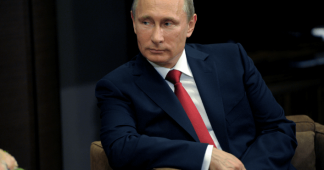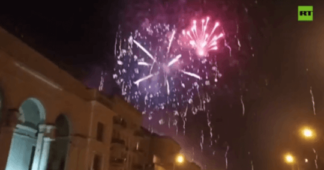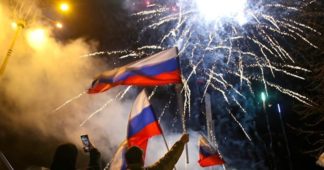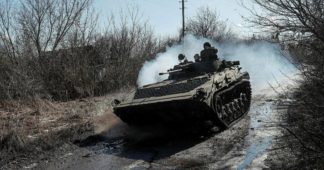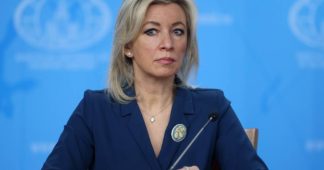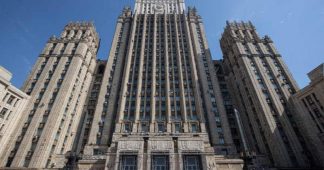By Dmitriy Kovalevich
Published on NCW, Dec 30, 2022
The year 2022 that became a turning point in the history of Ukraine is coming to an end. Thirty one years after the collapse of the Soviet Union, military conflict continues to rage in a number of Ukraine’s former regions while new hotbeds are smoldering. The military conflict in Ukraine has become the world’s largest, as measured by its impact on the global economy and by the ever-present danger that it could escalate into a new world war. Even the Pope in December identified the conflict in Ukraine as a “world war” which won’t see an “end” anytime soon.
Background to the conflict
Evidence that the Russian special military operation in Ukraine was inevitable and that all parties were preparing for it is shown by the continued shelling of Donbass towns and cities by Kyiv. This has been continuous during the past eight years. Donetsk city and region remains even now under intense fire by the artillery and mortars of the Kyiv regime, generously supplied by Western countries.
The Russian operation in Ukraine is actually the continuation of this long civil war in the Donbass region. Kyiv and its Western backers have refused to comply with the ‘Minsk 2’ peace agreement of February 2015. This envisioned a semi-autonomous status for the two Donbass republics of Donetsk and Lugansk within a new, power-sharing federal structure for Ukraine. But the Western countries involved wished to maintain a subjugated status for the two republics and to use that as a point of conflict aimed at weakening the Russian Federation.
For eight long years, the Russian Federation sought a diplomatic solution to the conflict using ‘Minsk 2’ as a political framework. By late 2021, it was clear that Kyiv and its NATO backers would continue to reject this and would continue their war. Failure to act was no longer an option for Moscow, not least because it would be discredited at home.
When Russia did intervene in February 2022, harsh sanctions by the West followed. The purpose of these was to bring down the Russian economy, stir popular discontent among the Russian people, and discredit the Russian leadership. In other words, the goal of the conflict in Ukraine since 2014 has not been change or improvement in Ukraine, but regime change in the Russian Federation. In the minds of the architects of that policy, regime change would open up free access by Western corporations to Russia’s huge energy resources.
A weakening of Russia would also see Western threats heightened against Russia’s neighbour in Asia, the People’s Republic of China. It is facing its own economic and ‘regime change’ threats, centered on the ‘weak link’ of Taiwan, the island province of China that has been courted and armed by the West to be used as a wedge to divide and weaken the People’s Republic.
Concerning ‘what happened’ to Minsk 2, former German chancellor Angela Merkel let the cat out of the bag in several interviews in early December (Die Zeit, and Der Spiegel) of this year discussing the fate of that agreement. She admitted that Minsk 2 was used by her government to buy time for Ukraine to build up its military strength and continue striking against Donbass. In Russia, Merkel’s revelations were met with astonishment, for they meant that the words of Western leaders mean nothing and they can no longer be trusted.
Vladimir Putin had always maintained cordial relations with Merkel. When Merkel’s revelation hit the news, he told Russian journalists, “It is disappointing. I did not expect to hear something like that from the ex-Chancellor. I always hoped that the German leadership was genuine. Yes, she was on Ukraine’s side, supporting it. But nevertheless, I genuinely hoped that German leadership expected a settlement based on the principles achieved… during the Minsk negotiations.”
He continued, “It appears to me that nobody planned to live up to these Minsk agreements… They lied to us, and the only reason for these processes was to pump Ukraine up with weapons and get it ready for military action. Well, we can see that. Maybe we were too late to realise what was happening. Maybe this [Russian military intervention] should have been started earlier.”
Since the Ukraine coup of 2014, pressure on the Russian government to act in defense of Donbass has come from the millions of Ukrainians who have moved to Russia for safety as well as large part of the Russian population as a whole.
Social versus neoliberal government policy
The basis for pro-Russian sympathies and influence in Ukraine comes not so much from any ethnic feelings (notwithstanding the fierce, right-wing and anti-Russia ethnic nationalism promoted by the governments of Ukraine) as the desire for greater social equality for the poorest in society. A significant role is played here by the social and economic conditions in Russia, which are far superior to those in Ukraine. The Russian Federation has much higher social assistance, pensions and salaries as well as low prices for electricity and heating. Ukraine, on the other hand, has been stubbornly following the recommendations of the IMF in recent years to subsidize and enrich local and foreign capitalist investors through the privatizations of state industries while cutting social spending.
Even a few Western journalists have reported on this. Russian troops withdrew from Kherson city and surrounding region in November. A report in France’s Le Monde on December 19 was headlined, ‘Through propaganda based on nostalgia for the USSR and generous pension payments, Russian occupation authorities found support among the elderly in Kherson’. In a random encounter with the Le Monde’s visiting correspondent, an elder resident of the city explains, “When the Russians were here, we had everything we needed and we were not afraid to walk in the street. Now we are just trying to survive!” Another says, “The Ukrainian soldiers are good for nothing, they don’t help us and only attract more shells.”
Pro-Western sentiments in Ukraine (as well as ‘pro-Ukrainian’ sentiments in the West) are mostly a result of large-scale media manipulations. In the Ukrainian conflict, the media component has sometimes been even more important than the economic or military campaigns. In this regard, Western media are far ahead of their Russian counterparts.
Ukrainian left-wing journalist Oleg Yasinsky, who lives in Chile, has written recently, “Ukraine has become not only a flashpoint between the forces of neoliberalism and humanity but also the largest media clash of our time. It is a country with a hologram state. Using the latest media technologies, it is trying to convince the world of reality as it sees it in order to generate the ‘public opinion’ that planetary elites need.”
Yasinsky says Ukraine has become a model that is being tested for use in Western countries themselves. Social discussion and debate at the top levels of government and civil society are suppressed, while police, economic and cultural repression is waged against all dissenters. He writes that representatives of yesterday’s leading European democracies can no longer criticize the neo-Nazi/neoliberal dictatorship in Ukraine because with each passing day, they differ from it less and less.
In this war, the Ukraine regime (or rather, its Western sponsors) pay little attention to the views and needs of Ukrainian soldiers. Instead, those who matter are the bloggers and ‘influencers’ who are trying to convince Western audiences to send more food and other humanitarian aid as well as weapons to the Kyiv regime.
War and humanitarian aid as massive money laundering
Much of the humanitarian aid provided to Ukraine by the United Nations other international organizations ends up stolen. According to local journalists and aid volunteers, on average, about half of humanitarian aid arriving in Ukraine immediately ‘disappears’.
The Ukrainian news journal Strana.ua published a story on December 15 showing photos by journalist Konstantin Ryzhenko of bread from the UN food mission being sold in a street market. The clear plastic packaging reads, ‘International Food Program of the United Nations’, implying, of course, that it was intended for free distribution to those in need.
“The information people are sending to me is shocking,” Ryzhenko tells Strana. “Quantity, quality… Where do hundreds of tons of humanitarian aid go? Wherever you go, 40-100-200 tons of humanitarian aid arrived but people have nothing. And if they do receive something, then it is bullshit [of poor quality]”, he explains. He calls the humanitarian aid that reaches people ‘bullshit’ because it often consists of date-expired food products that may no longer be edible.
While humanitarian aid from abroad is being stolen and resold, many people are receiving ‘aid’ in the form of expired products from Ukrainian supermarkets. On December 21, there was an attempted assassination of Konstantin Ryzhenko near his home in Kiev.
With such concerns of theft and reselling of humanitarian food aid, one can only imagine what is happening with the billions of dollars being spent on weapons aid. That information is strictly classified by the Ukraine regime. What was supplied to its military and by what company, how much profit was earned – only future generations may eventually unearth such information.
Suppression of free speech to fight the Russian threat
More than a dozen opposition parties have been banned and most media outlets have been closed in Ukraine this year. But that hasn’t stopped the outcries locally and abroad to ‘defend democracy in Ukraine’. What little free media remains in Ukraine is constantly obliged to simply reproduce the statements and information issued by the Office of the President of Ukraine, under threat of losing its licenses.
In December, Ukraine’s parliament passed a controversial media law allowing Kyiv authorities to shut down or block any media outlet without explanation and without a court decision. It prohibits any criticism of the actions of the Ukrainian government (excepting that media which receives Western grants). Months ago, the European Federation of Journalists called the proposed law “worthy of the worst of authoritarian regimes”.
Ukrainians as human shields
Ukraine initially appeared to adopt tactics of urban street fighting, on the advice of British military instructors. Evacuations of civilian populations were not necessarily carried out, or were not done so in a timely way. This is already something of a war crime. By contrast, defense lines built by self-defence forces for Donetsk city were situated well outside the city. Hundreds of thousands of Donbass residents were evacuated to safety and comfort in Russia in advance of it launching its military intervention.
According to Reuters, citing Russian Foreign Minister Sergey Lavrov, more than one million Ukrainians evacuated to Russia by the end of April 2022, including some 120,000 from the Donbass republics. Lavrov said Russia was expecting several million more. And indeed, Statistica reports that as of early October 2022, nearly three million Ukrainians have moved to Russia. (The pre-war population of Ukraine is estimated at 42 million.)
In November, President Zelensky bluntly explained why he had abandoned plans to evacuate Kyiv and other major cities after Russia began to strike electricity transmission stations located there. “If there are no people in the city, then the missiles will be everywhere,” Zelensky said, thereby contradicting claims by his own government that Russia was targeting the civilian population and confirming the accusations by critics that Kyiv is using civilians as human shields. Imagine for a moment the uproar in Western media if such a statement were made by the leader of a country in conflict with the West.
Instigation of religious wars
In December, Ukrainian intelligence agencies launched a campaign to ban the traditional Ukrainian Orthodox Church, accusing it of links to its ‘sister’ Russian Orthodox Church. Searches and arrests have taken place in many monasteries throughout the country, despite the formal existence in Ukraine of ‘freedom of religion’. According to photographic ‘evidence’ provided to media by the SBU (Ukraine’s federal secret police agency), searches of monasteries have turned up such ‘incriminating evidence’ as a bust of the Russian poet Alexander Pushkin, a map of the Moscow Metro, prayer books published in the Russian Federation, and several Russian 10-ruble coins (worth about 14 US cents each).
In Lviv, one priest detained by police had correspondence on his phone in which he blamed NATO for the current conflict in Ukraine and wrote that Western countries intended to fight to the last Ukrainian. In Ternopil, the SBU reported a suspicion of treason against the rector of the Pochaev Theological Seminary. His accused “anti-Ukrainian activities” included the dissemination of “Russian narratives” in an anonymous Facebook profile.
Some of the arrested Orthodox monks and priests have been exchanged for Ukrainian prisoners of war. One of the reasons for the persecution of the church is precisely for the purpose of prisoner exchanges, since Russia is holding many times more prisoners of war than Ukraine. Thus has an already-inflated religious conflict between the Russian Orthodox Church and its breakaway Ukrainian counterpart intensified. In history, religious conflicts have always been very difficult to extinguish.
The search by the Kyiv regime, targeting Ukrainians, for “collaborators and Russian agents” has been significantly expanded and strengthened of late. In addition, under this pretext, personal vendettas are being waged. Businesses with alleged ‘Russian links’ are being squeezed out in the Kherson/Kharkov region. Extortion is demanded to ‘remove’ criminal accusations against individuals for ‘collaboration’ with Russia. Arrests are even made for correspondence with relatives deemed to be suspect. The Ukrainian Telegram channel ‘Resident’ writes that the SBU has arrested some 4,000 civilians for the purpose of prisoner exchanges with Russia.
The war loans funded by Western taxpayers
On December 6, the Day of the Armed Forces of Ukraine, Prime Minister Denys Shmyhal stated that absolutely all taxes paid by citizens and enterprises are being directed to meeting military needs. The total military costs to Ukraine have amounted to more than $US 30 billion, of which two-thirds has gone to pay the salaries of the military. The remainder of military expenses, according to Shmyhal, are being borne by Ukraine’s Western allies. Earlier, the minister of finance of Ukraine, Serhiy Marchenko, argued that Ukraine finances only one third of its budget expenditures from its own revenues; the remaining two-thirds are provided by foreign sponsors and creditors.
In other words, Kyiv is conducting hostilities clearly beyond its means, and the functioning of the Ukrainian state is now dependent on the generosity of Western partners. This amounts to a loss of sovereignty, making all of Ukraine into a sort-of private military company.
Most of the funds allocated to Kyiv are in the form of loans, classified according to interest rate and repayment schedules. By the beginning of 2022, Ukraine’s external debt was already some 65% of the country’s GDP; by November 2022, the foreign debt had surpassed the country’s annual GDP.
In total, every Ukrainian, including children and babies, already owes some US$7,000 to Western creditors. But this figure is based on an estimated population of 42 million in 2014 (including the population of Donbass at the time). If we take into account that many millions of Ukrainians have left the country and a number of regions have seceded from Ukraine, then the remaining population will bear a double burden, perhaps in the order of $14,000 per capita. The average Ukrainian does not earn such an amount in a year. Simply put, the growing debt is unpayable. Ukrainians are repaying such loans with their lives, for the interests of foreign creditors.
Billions of dollars have been shelled out by Western taxpayers to assist the Kyiv regime’s war, but Ukrainians will be left indebted for generations to come. Funds that could otherwise serve to make social improvements and lessen the assaults on the planet’s natural environment, in Ukraine and in the West, are being wasted. This fraudulent scheme is very beneficial for Ukrainian and Western leaders and arms manufacturers. For them it is desirable that this war go on forever. For the rest of the world, this is a tragedy.
Anticipation of conflict in 2023
In 2023, both sides in the conflict are likely to continue and even escalate active hostilities. We do not know the military plans of the Russian, Ukrainian and NATO military leaders, but so far, all sides are talking about the need to defeat the enemy. The “peace initiatives” recently put forward by Zelensky require a surrender of the Russian Federation and the payment of reparations. This is quite unrealistic, to say the least. Hungarian Prime Minister Viktor Orban said in an interview with Magyar Nemzet at the end of December: “Ukraine can continue to fight only as long as the United States supports it with money and weapons. If the Americans want peace, then there will be peace.” In other words, even the leader of NATO member Hungary recognizes who the prospects for peace in Ukraine depend upon.
In military terms, terrible fighting in and around the small city of Bakhmut (population 75,000) is taking place. (In Donetsk, the city is called Artyomovsk, named after the famous Bolshevik Party leader Fyodor Andreyevich Sergeyev (1883-1921) whose code name was ‘Comrade Artyom’.) The fighting there has been going on for four months and the city has become a graveyard for thousands of Ukrainian servicemen. They talk on social media that fighting in Bakhmut means a quick death, or in the “best” case, a serious injury.
Russian military expert Vasily Dandykin claims that the armed forces of the Russian Federation are holding down Ukrainian troops near Bakhmut and thus giving time to prepare a large-scale offensive operation in the remainder of the Donetsk republic still in Ukrainian hands. “The Russian Federation is building up forces. Indeed, there is an opportunity to correct some of the mistakes of the past and start moving forward again in the Zaporozhye and the Kherson regions.We need to liberate these regions. But first, you need to be well prepared. The choice of the season, by the way, is also important. Winter is ahead and the help of ‘General Frost’ will be useful,” says the Russian expert.
At the same time, Deputy Foreign Minister of the Russian Federation Mikhail Galuzin says that any forecasts regarding the end of the Ukrainian crisis may turn out to be irrelevant if the military confrontation becomes protracted. The interests of the military-industrial complex of NATO countries, primarily the United States, also indicate that the conflict may take on a protracted character.
Ukraine is reportedly expending 14,000 shells every two days, yet the US military-industrial complex only produces such a quantity in one month. Continued US military assistance to Kyiv will require a ramp-up of mass production of armaments and the construction of new military factories. Large investors will only invest in such military enterprises if they are confident that the war will not end quickly.
In other words, the more money American investors invest in long-term arms production programs, the longer Ukrainians will continue to die. Indeed, this is what the Hungarian prime minister was talking about in the earlier citation from him. As the human resources of the Ukrainian armed forces are depleted, mercenary fighters from other countries may enter hostilities in larger numbers (as was the case in Syria). Thousands are already fighting on the side of the Armed Forces of Ukraine.
The World Bank predicts that by the end of 2023, 55% of the population of Ukraine will live below the poverty line. The official poverty line in Ukraine is a mere 2,589 UAH per month ($70). That is about the daily cost of a loaf of bread and a liter of milk. How are electricity, heating and so many other costs of daily living to be covered?
The only area where Ukrainians now consistently receive a respectable salary is the armed forces, some 20,000 to 30,000 UAH per month (US$500 to $750). But the risk of death is very high. Despite the risk, amidst conditions of mass unemployment and impoverishment, this remains the only realistic source of income for many in the country.
Western countries may rightly fear that in the event of an end to the military conflict in Ukraine, some one million unemployed male Ukrainians with experience in military operations will seek to emigrate to the West, looking for work. Many will be suffering the psychological disorders associated with war, and in the West they will find radical, right-wing Ukrainian paramilitary groups urging them to join.
All these factors will contribute to prolonging the conflict in Ukraine.
We remind our readers that publication of articles on our site does not mean that we agree with what is written. Our policy is to publish anything which we consider of interest, so as to assist our readers in forming their opinions. Sometimes we even publish articles with which we totally disagree, since we believe it is important for our readers to be informed on as wide a spectrum of views as possible.
